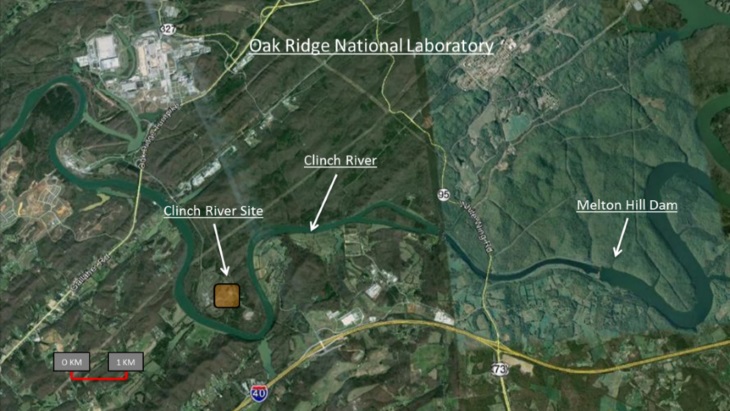High-voltage power lines carry electricity generated by the Tennessee Valley Authority to Oak Ridge National Laboratory. (Photo: Dobie Gillispie/ORNL, DOE)
The Tennessee Valley Authority and Oak Ridge National Laboratory have signed a memorandum of understanding to advance decarbonization technologies in pursuit of the federal government’s net-zero-by-2050 goal, the utility and the lab announced yesterday in a joint press release.
Fuel preparing to be unloaded outside of Vogtle-3 last month. (Photo: Georgia Power)
Commercial operation dates for the two new reactors under construction at the Vogtle nuclear plant have been pushed back yet again, adding to the project’s total cost, Southern Company announced last week. The Vogtle plant is near Waynesboro, Ga.
During its February 17 fourth-quarter earnings call, Southern reported that the projected start dates for both reactors were being extended by three to six months. Vogtle-3 is now expected to begin providing electricity to Georgians in the fourth quarter of 2022 or first quarter of 2023, with Vogtle-4 coming on line in the third or fourth quarter of 2023.
An advanced nuclear reactor technology park is hoped for the 935-acre Clinch River site. Image: TVA
The Tennessee Valley Authority’s board of directors has given the go-ahead for a program that will explore the development and potential deployment of small modular reactors as part of the utility’s decarbonization strategy.
A screen capture from the meeting that discussed the pathway to net-zero emissions by 2050: (From left) Leah Parks, Giulia Bisconti, Nicholas McMurray, Josh Freed, and Laura Hermann. Panelists who joined the meeting virtually were Sama Bilbao y León and Edie Greaves.
The Thursday morning executive session at last week’s 2021 ANS Winter Meeting and Technology Expo brought together a group of influential nuclear-policy experts from the United States and abroad to discuss the roles nuclear can play in smoothing the pathway to net-zero emissions by 2050. Specific topics explored included the Clean Energy Ministerial (CEM) and its Nuclear Innovation Clean Energy (NICE) Future initiative, as well as last month’s COP26 climate conference in Glasgow. The session was moderated by Leah Parks, a Nuclear Regulatory Commission risk analyst and 2020 ANS Presidential Citation awardee.
Artist’s rendering of a BWRX-300 plant. (Photo: GE Hitachi Nuclear Energy)
Ontario Power Generation (OPG) has selected GE Hitachi Nuclear Energy (GEH) as its technology partner for the Darlington nuclear new-build project. The companies will work to deploy GEH’s BWRX-300 small modular reactor at OPG’s Darlington nuclear plant, located in Clarington, Ontario.
Framatome’s PROtect accident tolerant fuel assembly undergoes final inspection before delivery to Exelon’s Calvert Cliffs-2 in Lusby, Md.
The nuclear industry’s first 100 percent accident tolerant fuel assembly is in operation at Exelon Generation’s Calvert Cliffs plant, the Department of Energy announced yesterday. The advanced fuel will operate in the reactor for the next four to six years and will be routinely inspected to monitor its performance, the DOE said.
Located in Lusby, Md., Calvert Cliffs houses two pressurized water reactors. Unit 1 is rated at 907 Mwe, and Unit 2 at 881 Mwe.
North Dakota Sen. Kevin Cramer speaks at a November 3 press conference announcing the American Energy, Jobs & Climate Plan.
A trio of Republican lawmakers from Western states—Sens. Dan Sullivan (Alaska), Kevin Cramer (N.D.), and Cynthia Lummis (Wyo.)—held a press conference at the Capitol yesterday to announce the American Energy, Jobs & Climate Plan, a response to what they termed the “Biden-Kerry Green New Deal.” Also in attendance were fellow Republican senators Ted Cruz (Texas), John Kennedy (La.), and Rob Portman (Ohio).
The plan is “an innovative clean energy and climate strategy with the potential to reduce global [greenhouse gas] emissions by up to 40 percent from today’s levels by 2050 and create thousands of jobs for hard-working Americans,” according to a press release from Sullivan’s office.
In April, the Biden administration announced a target of net-zero GHG emissions by 2050, with an interim target of a 50–52 percent reduction from 2005 levels by 2030.
eVinci micro reactor core, (Illustration: Westinghouse)
A recently completed feasibility study by Westinghouse Electric Company and Bruce Power concludes that the eVinci microreactor is capable of providing cost-competitive clean energy to decentralized, off-grid markets in Canada.
The Darlington nuclear power plant.
The Canadian Nuclear Safety Commission has approved the renewal of the site preparation license for Ontario Power Generation’s Darlington new-build nuclear project. First granted in 2012, the license is now valid until October 11, 2031.
Canada's Bruce nuclear power plant. (Photo: Chuck Szmurlo)
Canada’s Bruce Power, operator of the eight-unit Bruce nuclear power plant in Kincardine, Ontario, is undertaking a series of environmental initiatives to help attain its goal, announced in March, to achieve net-zero greenhouse gas emissions from site operations by 2027.
U.S. energy secretary Jennifer Granholm and IAEA director general Rafael Mariano Grossi pose for a photo before their September 21 meeting announcing the next International Ministerial Conference on Nuclear Power in the 21st Century. (Photo: D. Calma/IAEA)
U.S. energy secretary Jennifer Granholm and International Atomic Energy Agency director general Rafael Mariano Grossi met in Vienna yesterday during the agency’s 65th General Conference to launch preparations for the next IAEA International Ministerial Conference on Nuclear Power in the 21st Century, slated for October 26–28, 2022, in Washington, D.C.




.jpg)
 The International Energy Agency’s newly published in-depth review of Canada’s energy policies, the first since 2015, urges the nation’s government to take more action in support of nuclear energy.
The International Energy Agency’s newly published in-depth review of Canada’s energy policies, the first since 2015, urges the nation’s government to take more action in support of nuclear energy.


 A
A 



 Doubtless with the intention of influencing some of the many nuclear agnostics expected at next week’s COP26 Climate Change Conference in Glasgow, the International Atomic Energy Agency last week released
Doubtless with the intention of influencing some of the many nuclear agnostics expected at next week’s COP26 Climate Change Conference in Glasgow, the International Atomic Energy Agency last week released 


 The International Atomic Energy Agency has revised upward its projections regarding the potential growth of nuclear power’s capacity for electricity generation over the next three decades. The upward revision is the first by the IAEA since the Fukushima Daiichi accident in 2011.
The International Atomic Energy Agency has revised upward its projections regarding the potential growth of nuclear power’s capacity for electricity generation over the next three decades. The upward revision is the first by the IAEA since the Fukushima Daiichi accident in 2011.